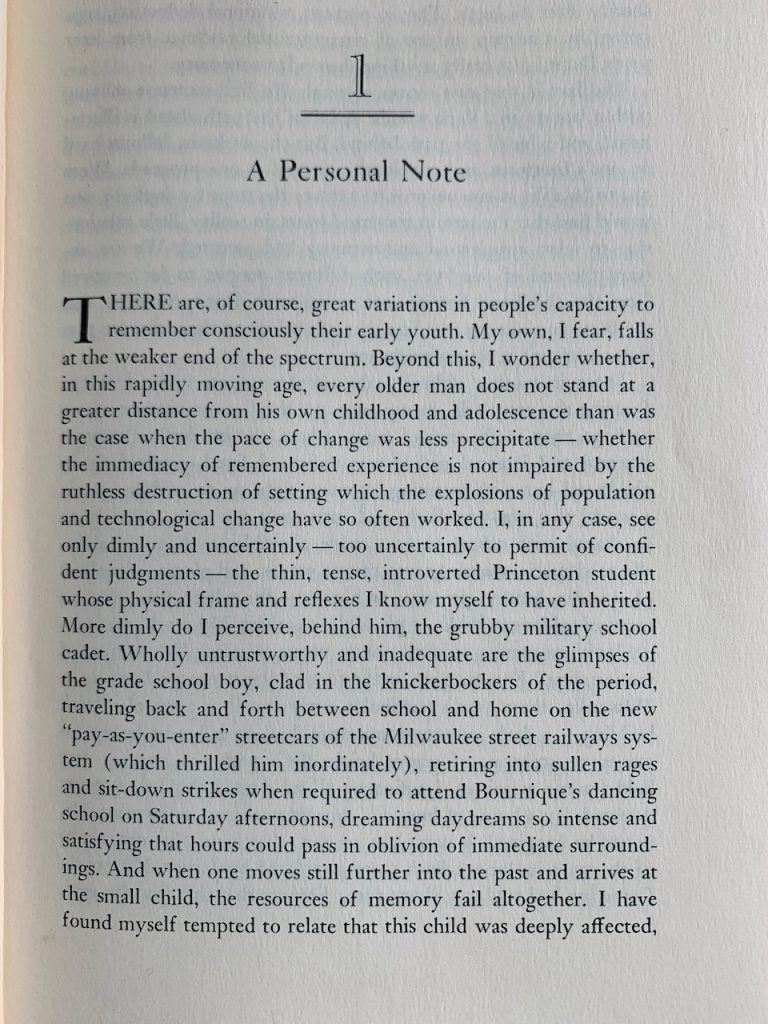“I love the way my favorite author breaks their content into paragraphs.”
Has anyone ever said that? I doubt it. Paragraphs are overlooked workhorses of prose writing.
You may have learned how to write the “five sentence paragraph” in school: one topic sentence, three detail sentences, and a conclusion. Once you survived that ordeal, you probably never thought about it again. (I certainly didn’t.)
As readers, we rarely notice the writer’s paragraph decisions except in extreme cases — like opening a book and finding that the first two pages are all one paragraph.
For example, here’s the first page of the first volume of George Kennan’s memoirs (by a man who would not even write a short telegram!)
Paragraphs operate on three distinct levels for the reader:
- Meaning: Sentences within a paragraph belong to and support the same idea. Paragraph breaks give the reader’s brains a nanosecond to synthesize that idea and move on.
- Visual impact: Paragraphs arrange the meaning on the page or screen. The breaks offer welcome white space. Our eyes notice the density of the words.
- Voice: Paragraph breaks contribute to rhythm and flow. Like a subtle movie soundtrack, the paragraph structure can set a mood—especially when a single sentence paragraph stands alone in a sea of longer ones.
Assess your paragraph habits
Most of us pick up habits and expectations, both as readers and writers.
As readers of physical books, we expect to see long paragraphs in certain types of works, like immersive fiction and academic works. Reading online, however, long paragraphs may deter us. (When I see a wall of online text, I am always tempted to click away.) Because I do so much writing for online reading, my default has shifted to shorter, two- to three-sentence paragraphs. When writing books, I opt for longer ones.
(The paragraph above looks pretty long on my blog, and I’m so tempted to break it up!)
I am also a big fan of planting pithy points or irreverent asides as single sentence paragraphs. Like the one above.
Are you curious about your own expectations? Explore a few writers that you enjoy and, just as we did with last month’s sentence patterns, look for their paragraph patterns. Notice of the interplay of long, short, and medium-length paragraphs, and see if you can detect a pattern. Then, try this month’s exercise yourself.
The exercise
Find something you’ve already written — at least a few pages worth of prose — and rewrite it alternating between long and short paragraph.
Long Short Long Short Long ShortThe rules are flexible. You can start with either a long or short paragraph, and you get to decide what counts as short.
You may need to rearrange ideas to make it work. If your initial draft uses many long paragraphs,
- Try isolating important points or entertaining asides in their own paragraphs.
- Make a transitional sentence its own paragraph and see what that does to the flow.
If the initial paragraph has many short paragraphs, look for connective threads that link sentence or ideas together and group them.
Then, compare the drafts to see if and how your writing voice has shifted between the version.
- If you added short paragraphs, does that make your voice seem less formal? More emphatic?
- If you added long paragraphs, does the result feel more serious? Flowing?
Pay attention to what this simple tool teaches you. Compare your default patterns to the choices of your favorite authors. You might decide to change your own paragraph habits to refine your writing voice.
More to explore
This topic maps to the sixth section of The Writer’s Voice. Find more voice-related exercises there — as a print book from Amazon, Bookshop, or as a PDF directly from me.
